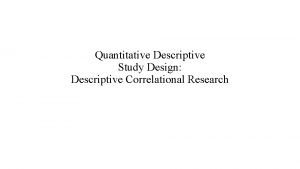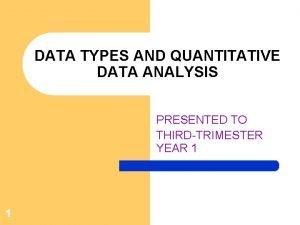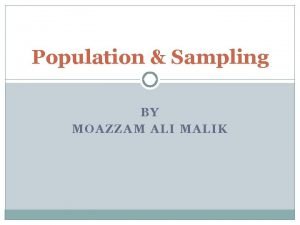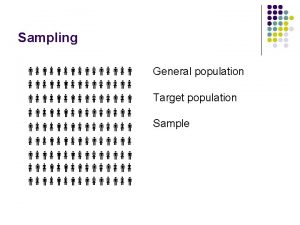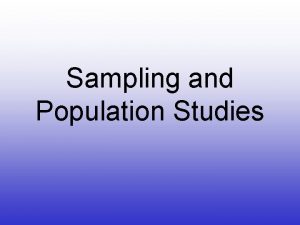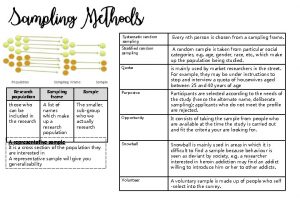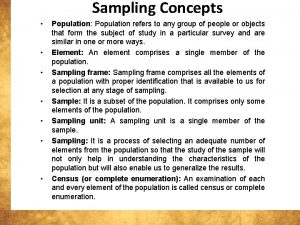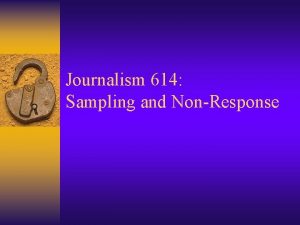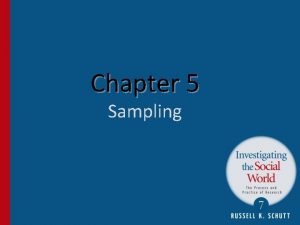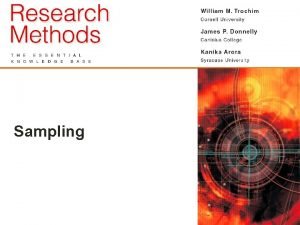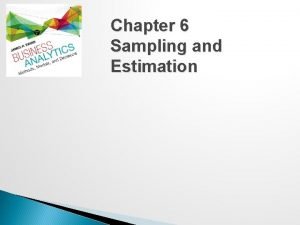SAMPLING IN QUANTITATIVE RESEARCH Population is a group






































- Slides: 38


SAMPLING IN QUANTITATIVE RESEARCH

Population is a group of interest to the researcher to whom he would like to generalize the results of his study. They always share a common set of characteristics. (Fraenkel, 2012)

Target population is the population to which the researcher would ideally like to generalize his study results (O-level students in Lahore, Parents of a. c. ). It is rarely available. Accessible population is the population from which the researcher can realistically select subjects, also known as available population. (O -level students in Gulberg, Parents of a. c. residing in Lahore). (Gay 2012)

In research, sampling is the process of selecting individuals or portion who will participate in study or on which study will be conducted. What is the appropriate sample design? To decide on the most appropriate sample design for a research, the researcher will • First identify a number of sample criteria. • Second evaluate the relative importance of criteria.

Samples should be as large as a researcher can manage with given time, money and energy. A recommended number of subjects is 100 for a descriptive study, 50 for correlational study, and 30 in each group for experimental and casualcomparative studies. (Fraenkel 2012)

• Define the target population • Select accessible population • Determine sampling method • Plan process for selecting sampling units • Determine sample size • Select actual sampling (Zikmund 2012) units

Probability Sampling Non Probability Sampling

Probability sampling techniques permit the researcher to specify the probability or chance that each member have for being selected. 1. 2. 3. 4. Simple random sampling Stratified sampling Cluster sampling Systematic sampling

A simple random sample is one in which each and every member of the population has an independent chance of being selected. Steps in simple random sampling. • One way to do this is to write each persons name on a piece of paper, place all slips in a container, shake the container and select a slip. Repeat till desired number of sample is selected. But this method is not satisfactory if the population is large.

• For larger populations, table of random numbers is used- an extremely large list of numbers that has no pattern or order. Steps in selection are; • Identify and define the population (all students studying nutrition in O-levels in Lahore) • Determine the desired sample size (60 for nutrition students) • List all members of population (take names from school rolls) • Assign all individuals on the list a consecutive number from 0 to the required number (000800)

• Select an arbitrary number (close your eyes and point!) • For the selected number, look only at the number of digits assigned to each population member. If the population has 3 digits look at last 3 digits, if has 2 digits look at last 2 (in case of population of 200 select half numbers from 3 digits and half from 2 digit) • If you select a number larger than the number of population ignore that number (955 or 869) • Repeat last 3 steps till desired number of sample is reached.

Stratified sampling is a way to ensure desired representation of relevant subgroups within the sample. Stratified sampling involves strategically selecting participants from each subgroup (strata). Stratified sampling is of 2 types; proportional and disproportional.

is the process in which subgroups in the population are represented in the sample in the same proportion as they are in population. Example: If the population has 7000 males and 3000 females, the sample will have 70 males and 30 females.

is the process of selecting equal sized samples from subgroups if subgroup comparisons are required. Example: Even if there are 7000 males and 3000 females, the sample will have 50 males and 50 females.

• The selection of groups or clusters, of subjects rather than individuals is known as cluster sampling. Cluster random sampling is effective with larger number of clusters. Cluster sampling may be the only feasible method of selecting a sample. • When the researcher is unable to obtain a list of all members of the population. • When the population is spread over a wide geographic area. • When the researcher cannot select randomly due to administrative or other constraints such as time and expense.

• Identify and define the population (all students studying nutrition in O-levels in Lahore) • Determine the desired sample size (60 for nutrition students) • Identify and define a logical cluster (schools) • List all clusters that make up the population of clusters (schools offering food and nutrition in O-levels) • Estimate the average population members per cluster (15) • Determine the numbers of clusters by dividing the sample size with estimated size of a cluster (60/15) • Randomly select the required number of clusters. • Include in your study all population members in each selected cluster.

In systematic sampling, every kth number from the population is selected in the sample. In this type of sampling, all members do not have equal chance of being selected. After the first name is selected, all the rest of the individuals to be included in the sample are automatically determined. To guard against bias, the list of population can be randomly ordered.

• Identify and define the population (all the students studying nutrition in O-levels in Lahore) • Determine the desired sample size (60 for nutrition students) • Obtain a list of population (take names from school rolls) • Determine the kth number (800/60) • Start at some random point in the list. (close your eyes and point!) • Starting at that point, take every kth name on the list until the desired sample is reached (take every 13 th number)

• Random sampling is difficult to do because each member has to be identified. • In stratified sampling, researcher needs names of all population members. It is difficult to reach all selected in sample. In non-proportional stratified sampling sample does not represent the population.

• Disadvantage of cluster sampling is that there is more chance that sample does not represent the population. • In systematic sampling if the population has been ordered systematically-that is if the arrangement of individuals on the list is in some sort of pattern that accidentally coincides with the sampling interval a marked bias can result.

Non probability sampling employs a nonrandom selection process in which all the individuals and/or elements are not given an equal chance of being included in the sample. Non Probability sampling is less likely to produce a representative sample than compared to the Probability sampling methods.


• This type of sampling technique is used when the researcher wants to show that a certain trait exists in the entire population. • When randomization is not possible e. g. in cases of almost limitless populations. • When the researcher is conducting a pilot, exploratory or a qualitative study. • When the researcher has limitations of budget, time, resources, manpower etc. • When the researcher is not aiming to generalize results on the entire population.

1. Convenience sampling 2. Quota sampling 3. Theoretical/ Purposive sampling

In convenience sampling, samples are selected on the basis of availability and easy access by the researcher. Individuals/ elements were included only because they were available and convenient to recruit.

• It is the easiest, cheapest and the least time consuming sampling technique. Hence also the most widely used. Limitations • The researcher has no control over the representativeness of the sample. • Most convenience samples are not an accurate representation of the population. • It is quite likely that the sample will be biased.

In this type of sampling subjects are selected according to equal or proportionate representation as in the entire population. Proportions are defined with respect to known characteristics such as age, gender, socioeconomic status, education, religion, race etc. The researcher then uses convenience or judgment sampling to select individuals from the subgroups.

• Mostly the subgroups are defined by the variables of the study. • This technique is ideal if the researcher wishes to study a variable of a particular subgroup. • Study of relationships among subgroups is possible. • It can be applied if a sampling frame is not available. Limitations • However, the traits/ variables of the subgroups maybe over emphasized. • It may not be a total representation of the population and can be unreliable.

Purposive sampling is also known as “Judgmental sampling”. In this type of sampling the researcher intentionally selects the sample based on some previous knowledge about the population or based on a specific objective of the research. The individuals are selected on some criteria or common characteristics.

• The sample is selected using a set criteria/ characteristics. • The researcher only includes individuals of interest and excludes the rest. • It is cost & time efficient as it focuses on specified targets. Limitations • The researcher’s judgment may not always be accurate.

Sr. no 1. 2. Probability Sampling Non Probability Sampling It is used when we have a complete It is used when an exhaustive population list sampling frame. is not available. (no cmplt sampling frame) Random selection of samples from Not random. Each person/ unit is not given a population. All persons/ units have an chance of being selected. equal chance of being selected. 3. Results can be generalized. Results can Can be effective when trying to generate be applied to the entire population. ideas. Results may not be generalizable to the population. 4. Can be expensive and time consuming. More convenient and less costly

Research Methodology Sampling Method Frequently Used Tentative Sample Size Survey Research Random Sampling Proportional Stratified Sampling, Quota Sampling* 300 Case Study Single Subject Research Theoretical/Purposive Sampling 1 Group 1 individual Action Research Better to take whole class Random if population is large Experimental Research Causal-Comparative Research Systematic Sampling 30 in each group Correlational Research Stratified Sampling 50 -100

Sampling Error is the deviation of the sample from the population. It is due to individual differences within the sample, which may not truly represent the population. Sampling error is caused by chance. Sampling error can be avoided by selecting the entire population, but it is not possible in all cases. It can be minimized through randomization &probability sampling. It can also be reduced by selecting a larger sample size.

Sampling Bias is when some subjects/ individuals are preferred over others or when the sample is selected in such a way so as to yield favorable outcomes. It can be of two types: Omission Bias: When certain individuals or groups are intentionally excluded from the sample. Inclusive Bias: It occurs when certain individuals or groups are preferred over others. It may be due to convenience or to achieve favorable results.

Generalizability & External Validity are interrelated. External validity is the extent to which the results of a particular study can be applied from a sample to a population. External validity is used to judge the importance of a research. Researches with poor external validity are not taken very seriously.


 Random sampling method in quantitative research
Random sampling method in quantitative research Sampling techniques in research
Sampling techniques in research Probability vs non probability sampling
Probability vs non probability sampling Convenience sampling example situation
Convenience sampling example situation Cluster random sampling
Cluster random sampling Observasi event sampling
Observasi event sampling Cluster sampling vs stratified sampling
Cluster sampling vs stratified sampling Sampling frame in research example
Sampling frame in research example Natural sampling vs flat top sampling
Natural sampling vs flat top sampling Population vs sample
Population vs sample Chapter 4 population ecology section 1 population dynamics
Chapter 4 population ecology section 1 population dynamics Section 1 population dynamics answer key
Section 1 population dynamics answer key Population ecology section 1 population dynamics
Population ecology section 1 population dynamics Chapter 4 section 1 population dynamics study guide answers
Chapter 4 section 1 population dynamics study guide answers Research that involves a holistic investigation
Research that involves a holistic investigation What is quantitative example
What is quantitative example Appendices in research example
Appendices in research example Descriptive research design
Descriptive research design Descriptive research
Descriptive research Qualitative and quantitative data analysis
Qualitative and quantitative data analysis Descriptive correlation design
Descriptive correlation design Group studied is smaller and not randomly selected
Group studied is smaller and not randomly selected Different kinds of quantitative research
Different kinds of quantitative research Stages in the research process
Stages in the research process Data types in quantitative research
Data types in quantitative research Chapter 3 research methodology sample
Chapter 3 research methodology sample Key concepts in qualitative research
Key concepts in qualitative research Example of independent variable in quantitative research
Example of independent variable in quantitative research T-test in quantitative research
T-test in quantitative research Statistical treatment
Statistical treatment Quantitative research about cycling
Quantitative research about cycling Theoretical framework for business research
Theoretical framework for business research Types of methodologies
Types of methodologies Does qualitative research have hypothesis
Does qualitative research have hypothesis Conceptual phase of quantitative research
Conceptual phase of quantitative research What is conclusive research design
What is conclusive research design Significant of the study example
Significant of the study example Non-experimental quantitative research
Non-experimental quantitative research Disadvantage of quasi experimental design
Disadvantage of quasi experimental design




















